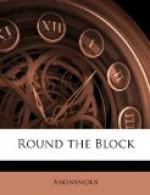“If you please, Mr. Cronner,” said Mrs. Crull, “I think you’d better go ahead with her examination at once. Quickest said, soonest mended, you know.”
The prisoner and his counsel having taken their seats, the coroner having involuntarily thrown his right leg into the old, easy position, the jury having pricked up their ears, the reporters having cleared spaces for their elbows, the young girl proceeded to give her testimony. She was too nervous to make a clear, connected statement. Sometimes terror, sometimes tears, would choke her voice; but the cheering words and the smelling bottle of Mrs. Crull invariably “brought her round in no time,” in the words of that estimable lady.
Pet told the story of her return home on the fatal night, of her finding Mr. Wilkeson and her father in angry conversation; of her retiring to bed very much fatigued; of more conversation, growing angrier and angrier, which she overheard; of her marvellous vision in the night; of her waking next morning to find her vision true, and her father dead on the floor. All these facts, with which the reader is already familiar, the poor child made known to the jury in a fragmentary, roundabout way, as they were elicited by questions from the coroner, the jury, and occasionally the prisoner’s counsel. The narrative of the vivid dream, or vision, produced a startling effect on the coroner, who was a firm believer in every species of supernaturalism winch is most at variance with human experience and reason.
In his interrogatories to the witness, the coroner took the truth of the vision for granted. When she testified to the blows which (in her dream) she saw her father and the prisoner exchange, and the battered appearance of Mr. Wilkeson’s face, the coroner looked at the prisoner, and was evidently disappointed to observe no traces of a bruise upon his pale brow or cheeks, nor the lightest discoloration about his eyes. But the absence of this corroboration did not, in the coroner’s opinion, throw the least discredit on the dream.
But the foreman of the jury, who had been listening with an affrighted look to the marvellous story, and believing it, had his faith sadly shaken by this discrepancy. Having been fireman ten years, and foreman of a hose company six years, he knew by large experience how long it took to tone down a black eye or reduce a puffed cheek. The foreman looked at the smooth, clear face of the prisoner, smiled incredulously, and shook his head at his associates.
Fayette Overtop here acted his part with a skill worthy of a veteran. Instead of making a great ado over this weak point of the dream, he shrugged his shoulders, and smiled faintly at the jury. The jurors, who had been inclined, up to this time, to accept the dream as evidence, without question, now decided that it was nonsense.
Marcus Wilkeson sat and listened, as if the scene and all the actors in it, himself included, were only a dream too. The young girl’s evidence, of which he had not an inkling before, would have astounded him, if anything could. But he had reached that point of reaction in the emotions, where a stolid and complete apathy happily takes the place of high nervous excitement. He somehow felt certain of his acquittal, but was strangely benumbed to his fate.




